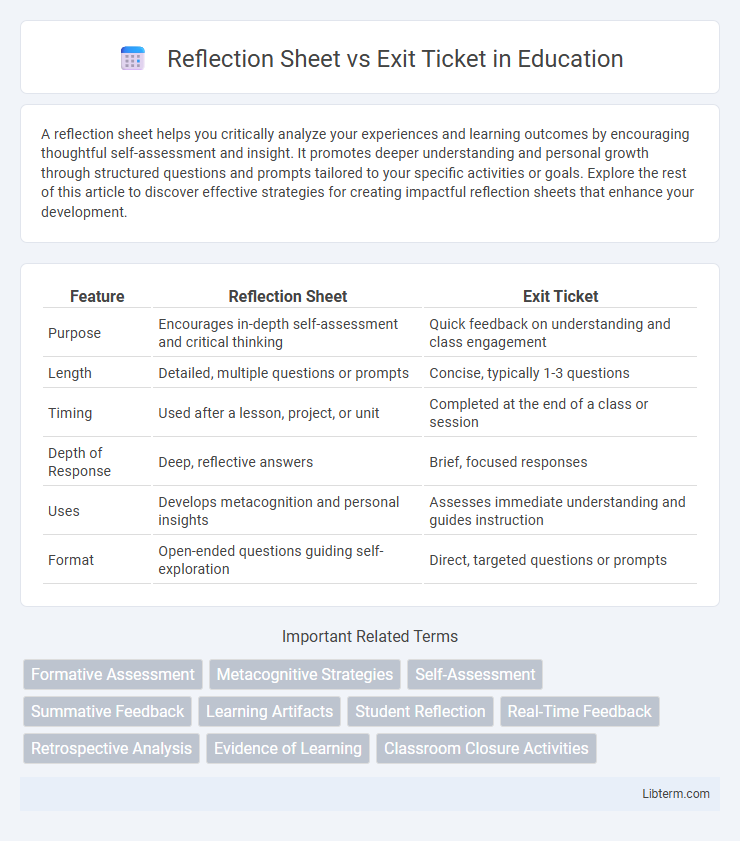A reflection sheet helps you critically analyze your experiences and learning outcomes by encouraging thoughtful self-assessment and insight. It promotes deeper understanding and personal growth through structured questions and prompts tailored to your specific activities or goals. Explore the rest of this article to discover effective strategies for creating impactful reflection sheets that enhance your development.
Table of Comparison
| Feature | Reflection Sheet | Exit Ticket |
|---|---|---|
| Purpose | Encourages in-depth self-assessment and critical thinking | Quick feedback on understanding and class engagement |
| Length | Detailed, multiple questions or prompts | Concise, typically 1-3 questions |
| Timing | Used after a lesson, project, or unit | Completed at the end of a class or session |
| Depth of Response | Deep, reflective answers | Brief, focused responses |
| Uses | Develops metacognition and personal insights | Assesses immediate understanding and guides instruction |
| Format | Open-ended questions guiding self-exploration | Direct, targeted questions or prompts |
Understanding Reflection Sheets
Reflection sheets capture students' thought processes by encouraging in-depth analysis of their learning experiences, promoting critical thinking and self-assessment. These tools document detailed insights into comprehension and emotional responses, enabling educators to tailor instruction effectively. Unlike exit tickets, which provide quick feedback on specific content, reflection sheets offer a comprehensive evaluation of student understanding over time.
What Is an Exit Ticket?
An exit ticket is a quick formative assessment tool used at the end of a lesson to gauge student understanding and gather immediate feedback. It typically consists of a few concise questions or prompts that help teachers assess learning outcomes and identify areas needing reinforcement. Unlike reflection sheets, which encourage deeper self-analysis, exit tickets provide targeted insights to inform instructional adjustments for subsequent lessons.
Core Purposes of Reflection Sheets
Reflection sheets primarily serve to deepen student learning by prompting thoughtful analysis of experiences and content, fostering metacognitive skills essential for self-assessment and personal growth. These tools encourage learners to connect new knowledge with prior understanding, enhancing retention and critical thinking. Unlike exit tickets, which typically capture immediate feedback or comprehension checks, reflection sheets emphasize broader insights and long-term learning outcomes.
Main Functions of Exit Tickets
Exit tickets serve as concise formative assessment tools designed to capture students' understanding of key concepts at the end of a lesson. They provide immediate feedback for educators to gauge student comprehension, identify misconceptions, and adjust instruction effectively. Unlike reflection sheets, exit tickets focus on quick, specific responses that inform real-time teaching decisions and learning progress.
Key Differences: Reflection Sheet vs Exit Ticket
Reflection sheets encourage deeper critical thinking and self-assessment by prompting students to analyze their learning experience in detail. Exit tickets, typically brief and focused, serve as quick formative assessments that gauge immediate understanding or gather feedback at the end of a lesson. The key difference lies in reflection sheets promoting extended personal insights, while exit tickets prioritize rapid content comprehension and classroom engagement.
Ideal Scenarios for Using Reflection Sheets
Reflection sheets are ideal in scenarios where deep student self-assessment and critical thinking are required to understand learning progress and areas for improvement. They are particularly effective after extended projects, complex topics, or units, allowing students to analyze their experiences and consolidate knowledge. Using reflection sheets in such contexts promotes metacognition and helps educators tailor future instruction based on detailed student insights.
When to Use Exit Tickets in Classrooms
Exit tickets are best used at the end of a lesson to quickly assess student understanding and gather immediate feedback on specific concepts taught. They help teachers identify areas where students struggle and inform adjustments for the next class or intervention strategies. This formative assessment tool is ideal for time-efficient checks that guide instruction without disrupting the flow of the overall lesson plan.
Benefits of Reflection Sheets for Deep Learning
Reflection sheets promote deep learning by encouraging students to critically analyze their understanding and identify areas for improvement, fostering metacognitive skills. These sheets provide detailed feedback opportunities, enabling personalized learning and long-term knowledge retention. Compared to exit tickets, reflection sheets support complex thinking processes and comprehensive self-assessment.
Immediate Feedback with Exit Tickets
Exit tickets provide immediate feedback by capturing students' understanding at the end of a lesson, enabling teachers to quickly address misconceptions and adjust instruction. Reflection sheets, while valuable for deeper student self-assessment, typically require more time to review and do not offer the prompt response that exit tickets ensure. The rapid turnaround of exit tickets enhances formative assessment, fostering timely interventions that improve learning outcomes.
Choosing the Right Tool for Student Assessment
Reflection sheets provide students with opportunities to articulate their understanding and thought processes, promoting deeper metacognitive skills assessment. Exit tickets deliver quick, focused feedback on specific lesson objectives, allowing teachers to gauge immediate comprehension efficiently. Selecting the right tool depends on whether educators aim to evaluate long-term reflection or immediate grasp of content, balancing depth of insight and formative assessment speed.
Reflection Sheet Infographic

 libterm.com
libterm.com